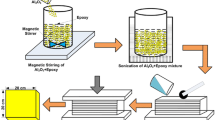Abstract
It is considered that the different placing thicknesses in casting of fiber-reinforced cementitious composite (FRCC) can be one of the factors affecting the fiber orientation and distribution, which is considered to be one of the most important influence factors of the bridging performance of fibers. In this study, a water glass solution is used to conduct the visualization simulation of the flow patterns of fresh mortar with short discrete fibers. Water glass has high viscosity, and it is colorless and transparent. The rheology of mortar matrix before mixing the fiber has been inspected using the flow time based on the test method for flowability of grout measured by the funnel. The orientation intensity that expresses the fiber orientation tendency for the principal orientation angle is calculated by counting the orientation angles of the black target fibers in the water glass solution of three different placing thicknesses. The effect of different placing thicknesses on the fiber bridging performance is considered in the calculation of the bridging law using the elliptic function characterized by the principal orientation angle and the orientation intensity. The results show that a smaller placing thickness in casting leads to a greater fiber orientation intensity and better tensile performance based on the bridging law.
Access this chapter
Tax calculation will be finalised at checkout
Purchases are for personal use only
Similar content being viewed by others
References
Ozu, Y., Miyaguchi, M., Kanakubo, T.: Modeling of bridging law for PVA fiber-reinforced cementitious composite considering fiber orientation. J. Civil Eng. Archit. 12(9), 651–661 (2018)
Kanakubo, T., Miyaguchi, M., Asano, K.: Influence of fiber orientation on bridging performance of polyvinyl alcohol fiber-reinforced cementitious composite. ACI Mater. J. 113(2), 131–141 (2016)
Author information
Authors and Affiliations
Corresponding author
Editor information
Editors and Affiliations
Rights and permissions
Copyright information
© 2023 The Author(s), under exclusive license to Springer Nature Switzerland AG
About this paper
Cite this paper
Zhang, H., Kanakubo, T. (2023). Influence of Placing Thickness on Fiber Orientation and Bridging Law of FRCC. In: Kunieda, M., Kanakubo, T., Kanda, T., Kobayashi, K. (eds) Strain Hardening Cementitious Composites. SHCC 2022. RILEM Bookseries, vol 39. Springer, Cham. https://doi.org/10.1007/978-3-031-15805-6_10
Download citation
DOI: https://doi.org/10.1007/978-3-031-15805-6_10
Published:
Publisher Name: Springer, Cham
Print ISBN: 978-3-031-15804-9
Online ISBN: 978-3-031-15805-6
eBook Packages: EngineeringEngineering (R0)




